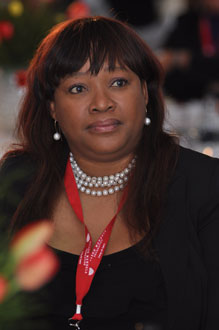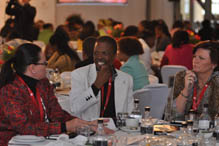
World Bank Country Director Botswana, Lesotho, Madagascar, Mauritius, Namibia, South Africa, and Swaziland Ruth Kagia
August 27, 2009 – Putting money into the hands of women is key to eradicating poverty, but there is a disparity, worldwide, between policies and the practice of actually investing in women.
This was the argument that Ruth Kagia, World Bank Country Director for Botswana, Lesotho, Madagascar, Mauritius, Namibia, South Africa and Swaziland, put forward in the second session of the third Malibongwe Dialogue, hosted by the Nelson Mandela Foundation at the Turbine Hall in Johannesburg today.
Kagia’s address followed one by South African Minister of Trade and Industry Rob Davies, which focused on micro-lending’s potential role in poverty alleviation.
In her address, Kagia provided numerous examples from around the world which showed that when money was put in the hands of women it led to a more sustainable economic situation for both their families and their countries’ economies.
Kagia cited studies from the Ivory Coast, Brazil and South Korea which indicated that money in the hands of women led to stronger economies and better living conditions for their families.
“The world is waking up to the fact that in most countries the greatest unexploited resources are women and girls,” Kagia said.
Furthermore, she argued, “there are no economies that I know of that are thriving in a sustainable way that don’t have gender equality”.
Kagia addressed her remarks in the context of a report in The Lancet, released this week, which highlights that gender inequality is still rife in South Africa.
“South Africa,” said Kagia, “has the dubious distinction of having five times more personal crime of intimate partners committing violence against women than is the global norm.”
This violence, she argued, was in part a result of the massive economic disparities between the rich and poor in South Africa.
Kagia nevertheless believes that poverty can be eradicated.
“Can we create a world without poverty? To quote the words of a fellow Kenyan, ‘yes we can’, but only if women fit into the framework of society,” she said.
Kagia argued that “three principal ingredients” determined poverty eradication. Those were: increasing human capital, skills, health and education; providing people with the opportunities to use those skills; and access to assets – land, finance or both.
“The question then is, why has such a simple concept not been applied equally to women?” Kagia asked. “In a sense, that is where our challenge lies. We know there is a very strong business case to invest in women and girls. And given the tremendous pay-off, why has progress taken so long? I’m not just talking about South Africa, I’m talking globally.”
In answering that question, Kagia said that there were three possible reasons why this concept had not been successfully applied. The first was that there was a huge gap between “policies and action, intentions and implementation”; the second was the breakdown in the family structure in South Africa, which undermined the role of women; the third, a corollary of the second, was that women were not seen as valuable members of South African society, and this impeded their access to investment.




